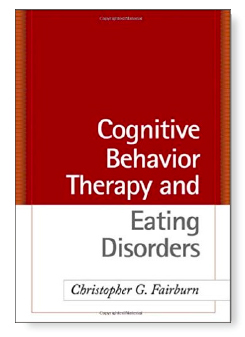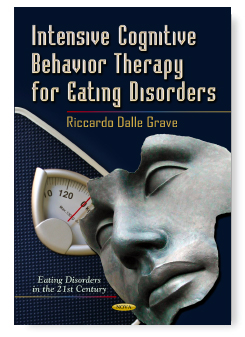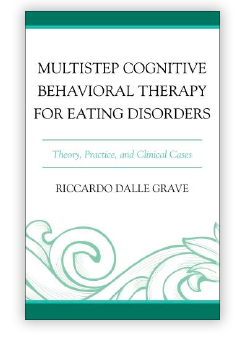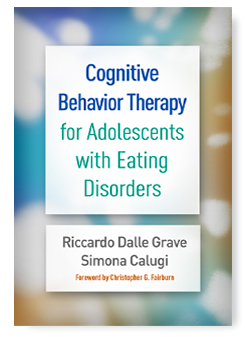We list below the books which are designed to guide therapists through the implementation of CBT-E. We prefer the term “guide” to manual.
Cognitive Behaviour Therapy for Adolescents with Eating Disorders
ISBN 9781462542734
> A Special Offer from Guilford Press:
Save 20% with Promotion Code 2E!
> Order from Guilford Press, a favorite bookstore or online vendor.
This book is available as a print or e-book.
This state-of-the-art guide provides a powerful transdiagnostic approach for treating adolescent eating disorders (anorexia nervosa, bulimia nervosa, binge-eating disorder, and others) in either outpatient or inpatient settings. It describes how enhanced cognitive behavior therapy (CBT-E)—the gold-standard treatment for adult eating disorders—has been systematically adapted and tested with younger patients. With a strong motivational focus, CBT-E gives the adolescent a key role in decision making. The book presents session-by-session guidelines for assessing patients, determining whether CBT-E is appropriate, developing case conceptualizations, conducting individualized interventions, addressing medical issues, and involving parents.
CBT-E is recognized as a best practice for the treatment of adolescent eating disorders by the U.K. National Institute for Health and Care Excellence (NICE).
Reviews of Cognitive Behavior Therapy and Eating Disorders
This is an important book. It fills two major gaps. For clinicians, it provides a detailed guide to the treatment of any form of eating disorder seen in adolescents. For researchers, it specifies for the first time how this empirically supported treatment, ‘enhanced cognitive behavior therapy’ (CBT-E), should be implemented with young patients….Too often, treatment manuals are written by treatment ‘gurus’ or researchers who engage in little or no ongoing face-to-face clinical work…. This book is entirely different, as it has been written by two experienced practitioners, both of whom are active clinically. The result is a truly useful guide.
— from the Foreword by Christopher G. Fairburn, DM, FMedSci, FRCPsych, Wellcome Principal Research Fellow and Professor of Psychiatry, University of Oxford, United Kingdom
Eating and weight issues in adolescence can be disabling and can have lifetime effects. Written by two outstanding clinician-scholars, this very accessible book shows how to deliver empirically based, state-of-the-art treatment that is tailored to the individual. With thoughtfulness and care, the authors capture the complexities of describing eating disorders in adolescents and discuss ways to navigate the thorny issues of patient and family engagement. An important book.
— Kelly D. Brownell, PhD, Robert L. Flowers Professor of Public Policy and Professor of Psychology and Neuroscience, Duke University
Dalle Grave and Calugi, two respected CBT experts, have produced a vital manual that walks the clinician through engaging and treating adolescents with eating disorders. This is a well-written book that describes how to deliver CBT-E to younger patients in a flexible, individualized, and effective manner. An indispensable resource for clinicians and supervisors, the volume provides clear, practical guidance rooted in emerging scientific evidence.
— Carlos M. Grilo, PhD, Director, Yale Program for Obesity, Weight, and Eating Research, Yale University School of Medicine
Treating adolescents with eating disorders remains a significant challenge, in part because few treatments have garnered efficacy data that promote confidence in their application. With this detailed, comprehensive treatment manual, Dalle Grave and Calugi take the field a significant step forward. These authors have been at the forefront of the development of a transdiagnostic application of CBT-E for adolescent eating disorders, and this manual will be a most valuable tool for clinicians as well as clinical researchers.
— Daniel Le Grange, PhD, Benioff UCSF Professor in Children’s Health, Department of Psychiatry, University of California, San Francisco; Emeritus Professor of Psychiatry and Behavioral Neuroscience, The University of Chicago
Cognitive Behavior Therapy and Eating Disorders

This book is a practical guide to the implementation of CBT-E. It has been written with the practising therapist in mind. It describes CBT-E in fine detail from the very beginning when one first meets the person seeking help, through to post-treatment review appointments. It also explains how the treatment may be adapted for particular subgroups and settings.
Reviews of Cognitive Behavior Therapy and Eating Disorders
From the most prominent group in the world studying the nature and treatment of eating disorders comes this cutting-edge treatment guide, which spans all eating disorder diagnoses as well as conditions that fall outside current diagnostic criteria. Based on a solid empirical foundation, the transdiagnostic enhanced CBT approach will immediately become the gold standard for the treatment of eating disorders.
— David H Barlow, PhD. Professor of Psychology and Psychiatry, Boston University
Fairburn takes CBT to a new level. This book is written explicitly for clinicians, who will find the clearly written, practical guidance invaluable. Of particular interest are the authoritative description of the psychopathology of eating disorders and the lucid analysis of the management and treatment of underweight patients and those with multiple comorbidities.
— G Terence Wilson, PhD. Oscar K. Buros Professor of Psychology, Rutgers
Another milestone by the field’s foremost pioneer, this book explains how to treat eating disorders in exquisite detail, and does so with a rich theoretical and empirical foundation as its basis. This will be the authoritative volume for many years to come.
— Kelly D Brownell, PhD. Director, Rudd Center for Food Policy and Obesity, Yale University
Intensive Cognitive Behavior Therapy for Eating Disorders

The book describes a novel model of intensive treatment for eating disorders, one that is entirely cognitive behavioural in orientation. The treatment program is described in detail, with numerous clinical vignettes. The book explains how to adapt CBT-E for intensive clinical settings (intensive outpatient and inpatient treatment) and for severe eating disorder presentations. It also explains how a multidisciplinary team can apply a single psychotherapeutic treatment. Readers will gain knowledge on the use of a “manualised” treatment in a real world intensive setting. The book is suitable for all professionals working with eating disorders (e.g. psychologists, psychiatrists, physicians, dietitians, and educators), particularly for those working in a multidisciplinary team at an intensive level of care.
Multistep Cognitive Behavioral Therapy for Eating Disorders: Theory, Practice, and Clinical Cases

Multistep Cognitive Behavioral Therapy for Eating Disorders: Theory, Practice, and Clinical Cases describes a novel model of cognitive behaviour therapy (CBT) for eating disorders called multistep CBT-E. The treatment, derived from the transdiagnostic theory of eating disorders, extends the range in which standard CBT-E can be applied. It is designed to be applicable to three different levels of care (outpatient, intensive outpatient, inpatient), and to eating disorder patients of all diagnostic categories, ages, and BMI ranges. What distinguishing multistep CBT-E is the adoption of a multi-step approach which is conducted by a multidisciplinary CBT-E team including psychologists, dietitians, and physicians. The treatment also includes a family module for patients under eighteen years old, and assisted eating and group sessions, in adjunct to individual psychotherapy in the intensive levels of care. The first eight chapters provide an overview of eating disorders, the cognitive behavioural theory of eating disorders, how to build a CBT-E multidisciplinary team, how patients are assessed and prepared for the treatment, the general organisation, procedures, and strategies involved in the three steps of multistep CBT-E treatment, and how multistep CBT-E can be adapted for adolescents. In order to highlight the flexibility of the multistep CBT-E approach, Section Two of the book provides a detailed description of three clinical cases. The first case illustrates how outpatient CBT-E was adapted to treat a professional sportswoman affected by an eating disorder; the second describes the procedures and strategies applied in intensive outpatient CBT-E to treat a patient who did not improve with standard outpatient CBT-E; and the third case illustrates the procedures and strategies typically applied in inpatient CBT-E, showing how it can be used to help a patient with a longstanding eating disorder who has failed to respond to several outpatient treatments. In addition, abridged transcripts of relevant clinical sessions are included, to give interesting insight into the practical implementation of multistep CBT-E.
Reviews of Multistep Cognitive Behavioral Therapy for Eating Disorders: Theory, Practice, and Clinical Cases
Dr. Dalle Grave has developed a thoughtful adaptation of enhanced Cognitive Behavioral Therapy, referred to as Multistep CBT, which will allow more unified and consistent treatment for individuals suffering from eating disorders across inpatient and outpatient settings. Multistep enhanced CBT for inpatient settings will allow treatment planning that is driven by a single unified theoretical model, rather than the typical eclectic approach that is more fragmented, thus representing a curial step forward in providing the optimal evidence-based care for individuals with a variety of eating disorders.
— Eric Stice, Oregon Research Institute
Riccardo Dalle Grave is one of the people I most trust to connect empirically based treatments with the management of eating disorders in clinical settings. This book is unique, and will be valuable for a wide array of professionals working in the field.
— Kelly D. Brownell, Yale University
Riccardo Dalle Grave has provided the field with a truly innovative and clinically sensitive approach to a full range of levels of care for eating disorder patients. Most notably, he carefully minds the evidence base surrounding cognitive behavior therapy-enhanced as he outlines new applications in hospital-based environments. This remarkable text most clearly speaks to Dalle Grave’s strong appreciation of empirical science and his careful clinical wisdom as he strives to find effective ways to treat eating disorder patients in the greatest need.
— Stephen Wonderlich, University of North Dakota


